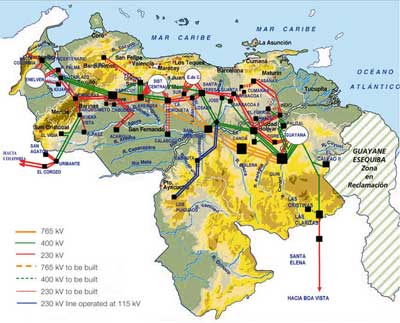Way way back in the late 70’s early 80’s I was working for Citi. One role I had was related to the construction of the Guri Hydroelectric dam in Venezuela (a minor involvement). The World Bank and Inter-American Development Bank provided a big chunk of the financing. All the big banks were lending money to the Venezuelan government and to the local electric company EDELCA. There were foreign contractors from every country involved. Money was moving in every different direction. I handled some of the FX transactions. As I result I became familiar/interested in this mega-construction project.
On paper, this was an absolutely beautiful project. A true perpetual energy machine was being created. The hydro dam was being located at what looked to be a perfect location. Two maps:
For millions of years the warm water of the Caribbean produced huge quantities of moisture that rose into the air and drifted southwest over Venezuela’s high plains. When that wet air runs into the Andes mountains it creates rain. Lots of it. This pattern created big rivers like the Orinoco that bring the water back to the ocean.
This endless cycle created an ideal condition for generating hydro power. So Guri was built. A 10,200 MW facility that flooded an area of 1,641 square miles. That’s big.
The flooded area was greater than the state of Rhode Island. The lake was 25Xs the size of the District of Columbia, 70Xs the island of Manhattan.
Your average coal plant produces only 700MW. A big nuke like the two units at Diablo Canyon produce only 2,300MW. Fukushima Daiich (4 units. Top ten globally) produced at its peak 4,700MW, less than half of the capacity at Guri.
Anything you might read about Guri will say it was a successful project. But here is my side story:
Many years later I was wearing a different hat. I was on the ‘buy-side’. Investing in (very) distressed assets. Venezuela was in the crapper at the time and EDELCA bonds (owner of Guri) were trading at 30 cents on the dollar with 5 years of interest coupons attached for free. So I took a look. I noticed that the MW production was substantially below what had been projected. I asked a guy I knew at the World Bank about it:
BK: Where’s the juice at Guri?
WB: Bad question to ask. The rainfall that historically fed the region has changed its pattern and annual flow. There are some who think that the enormous lake that was created changed the way the rain fell. Less water, less electicity.
BK: Incredible! Has this been proven? It would create a big stink if this were to come out.
WB: There will be no study. The dam has been built. No one wants to hear any bad news about this project. There are too many others like it being built around the world. The World Bank is promoting hydro power. We don’t want to tarnish what we build.
I was struck by this conversation. Man bites nature and nature bites back. For years I have wondered about this. There has been plenty of anecdotal evidence that big dams might cause changes in regional weather patterns. For example:






Recently this very important story from China has been making headlines.



ZH story (Link)
The region below the Three Gorges Dam has been in severe drought ever since the dam was opened. This headline had me looking again at the correlation between big dams and weather changes. Sure enough, just last February, a collaborative effort by Tennessee Tech, Purdue, U. Georgia, U. Colorado, and Pacific NW Labs confirmed what I had heard 20 years ago. The existence of a dam is directly associated with regional climate change according to the study: (Link)

From the article:
“This research shows you the smoking gun”
The study marks the first time researchers have documented large dams having a clear, strong influence on the climate around artificial reservoirs, an influence markedly different from the climate around natural lakes and wetlands.
“We know a lot about how climate change affects reservoirs, but what we didn’t know a lot about was what a reservoir could do to the local climate. We just reversed our thinking by saying that a reservoir and the activities it supports are just as important a player for climate as the larger climate is for the reservoir. Basically, it’s a two-way street.”
What are the conclusion(s) here? There is no energy creation mechanism that does not have big risks? That we are not as smart as we think we are when we build these giants? That China has lost a breadbasket forever?
I conclude that if you mess with nature you’ll get messed back. Hard.
- Bulenox: Get 45% to 91% OFF ... Use Discount Code: UNO
- Risk Our Money Not Yours | Get 50% to 90% OFF ... Use Discount Code: MMBVBKSM
Disclaimer: This page contains affiliate links. If you choose to make a purchase after clicking a link, we may receive a commission at no additional cost to you. Thank you for your support!





Awesome and informative article…. this effect needs to be publicized!